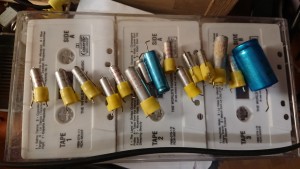 This is a very common player in Sweden since there seems to have been one in every classroom in Sweden up to the mid 90’s or so. Not all are in this condition though, even if they are built like tanks. 🙂
This is a very common player in Sweden since there seems to have been one in every classroom in Sweden up to the mid 90’s or so. Not all are in this condition though, even if they are built like tanks. 🙂
I got this from a radio amateur friend. He said it didn’t work, and it didn’t. Mechanically it was fine but there were just strange noises when I tried playback. Actually, very interesting noises… Everything from blowing wind to someone whispering something to heavy oscillations with varying frequencies. I though there was a bad capacitor or transistor somewhere but it turned out to be the rec/playback switch. These are open in these and all it needed was some gentle cleaning. Then it sprung to life and hasn’t acted up since (tested it for many hours now). These are very stable machines.








